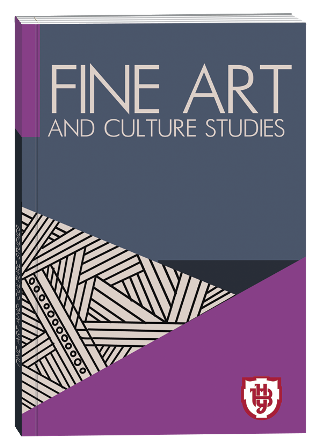VISUAL STRATEGIES OF SOCIAL POSTERS FOR WILDLIFE CONSERVATION
DOI:
https://doi.org/10.32782/facs-2024-5-27Keywords:
wildlife conservation, social poster, visual strategies, cognitive psychology, emotional impact, environmental awarenessAbstract
The article investigates contemporary visual strategies employed in social posters dedicated to wildlife conservation, with a particular focus on innovative design techniques. The work aims to analyze and evaluate the use of symbols, metaphors, visual contrasts, typographic elements, and color schemes that enhance the artistic representation of environmental themes. Through the lens of cognitive psychology, the research seeks to establish how these creative approaches contribute to forming impactful images that resonate emotionally with audiences, thereby raising awareness of wildlife protection issues. The methodology of the research involves a comprehensive analysis of visual techniques in social posters, emphasizing the integration of artistic elements that captivate viewers’ attention and foster a deeper understanding of ecological challenges. The study examines how metaphorical and symbolic devices are utilized to enhance the emotional impact of the posters, prompting critical reflection and action from the audience. This multi-faceted approach facilitates a nuanced understanding of the relationship between visual communication and public engagement in environmental conservation. The scientific novelty lies in the original exploration of how artistic strategies in social posters influence viewer perception and behavioral responses regarding wildlife conservation. This research uncovers new dimensions of metaphor and symbolism in poster design, demonstrating their pivotal role in facilitating effective communication and promoting ecological consciousness. The conclusions drawn from the study emphasize the importance of utilizing innovative visual strategies to create social posters that not only attract attention but also stimulate emotional engagement and foster a sense of responsibility toward nature. The findings underscore the need for further exploration into how specific visual elements can enhance the effectiveness of social messaging related to environmental issues. Future research directions may include investigating the psychological effects of particular design choices on audience perception and identifying the most impactful combinations of visual elements that encourage proactive ecological behavior.
References
Бачинський Г. А. Соціоекологія: теоретичні і прикладні аспекти / Г. А. Бачинський. Київ: Наукова думка, 1991. 152 с.
Бойчук О. В. Дизайн постіндустріальної епохи: нові виміри, нові вимоги / О. В. Бойчук // Вісник Харківської державної академії дизайну і мистецтв: зб. наук. праць. Харків: ХДАДМ, 2017. № 5. С. 66–72.
Гладун О. Візуальна мова графічного дизайну як комунікативна знакова система / О. Гладун // Вісник Харківської державної академії дизайну і мистецтв: зб. наук. праць. Харків: ХДАДМ, 2012. № 15. С. 11–14.
Гладун О. Український плакат: етапи розвитку візуально-пластичної мови / О. Гладун // Сучасне мистецтво. 2018. № 14. С. 115–121. DOI: 10.31500/2309-8813.13.2018.152212.
Голобородько В. М., Бойчук О. В., Свірко В. О., Рубцов А. Л. Екологічний дизайн: ґенеза стратегії / В. М. Голобородько, О. В. Бойчук, В. О. Свірко, А. Л. Рубцов // Вісник Харківської державної академії дизайну і мистецтв: зб. наук. праць. Харків: ХДАДМ, 2015. № 7. С. 15–19.
Голубець М. А. Від біосфери до соціосфери / М. А. Голубець. Львів: Поллі, 1997. 252 с.
Потапенко М. В. Семіотика в дизайні плакату / М. В. Потапенко // Інноваційні культурно-мистецькі аспекти в сучасній картині світу. Харків: ХНТУ, 2019. С. 141. URL: https://www.researchgate.net/publication/354204458_Semiotika_v_dizajni_plakatu.
Пушонкова О. Феномен примарного як явище сучасної візуальної культури / О. Пушонкова // Вісник Черкаського університету. Філософія. Черкаси: Вид. Черкаського університету, 2018. № 1. С. 79–87.
Сбітнєва Н. Ф. Історія графічного дизайну: навч. посібник / Н. Ф. Сбітнєва. Харків: ХДАДМ, 2014. 221 с. : іл.
Северіна О. М. Екологічний плакат: становлення та розвиток (за матеріалами трієнале «4-й Блок») : автореф. дис. ... канд. мистецтвознавства : 17.00.07 / О. М. Северіна. Харків: Харківська державна академія дизайну і мистецтв, 2010. 20 с.
Bennett R. J., Chorley R. J. Environmental Systems: Philosophy, Analysis and Control / R. J. Bennett, R. J. Chorley. London: Methuen, 1978. 624 p.
Chen R. Research on Public Welfare Poster Design Based on Cognitive Psychology – Taking the Poster Design for Wildlife Protection as an Example / R. Chen // Advances in Social Science, Education and Humanities Research. 2020. Vol. 515. DOI: 10.2991/assehr.k.210106.122.
Clarkson M. Elements of Visual Communication / M. Clarkson // Procomm IEEE. 2015. URL: https://procomm.ieee.org/elements-of-visual-communication/.
Frutiger A. Symbole: Geheimnisvolle Bilder-Schriften, Zeichen, Signale, Labyrinthe, Heraldik / A. Frutiger. Haupt, 2008.
Günay M. Design in visual communication / M. Günay // Art and Design Review. 2021. № 9. С. 109–122. DOI: https://doi.org/10.4236/adr.2021.92010.
Jenkins H. Textual Poachers: Television Fans and Participatory Culture / H. Jenkins. Routledge, 1992.
McIntosh R. P. The Background of Ecology: Concept and Theory / R. P. McIntosh. Cambridge: Cambridge University Press, 1985. 383 p.
Mertens G. Umwelten: Eine humanoekologische Paedagogik / G. Mertens. Paderborn; München; Wien; Zürich: Schoeningh, 1998. 245 S.
Reinders A., Diehl J. C., Brezet H. The Power of Design: Product Innovation in Sustainable Energy Technologies / A. Reinders, J. C. Diehl, H. Brezet. Oxford, UK: Wiley, 2012. 368 p. ISBN 978-1-1183-0867-7.
Zhao Y., Li W. The Combination of Cognitive Psychology and Creative Thinking Skills in Art and Design / Y. Zhao, W. Li // Applied Mathematics and Nonlinear Sciences. 2024. Vol. 9, Issue 1, January. DOI: 10.2478/amns.2023.2.00808.







